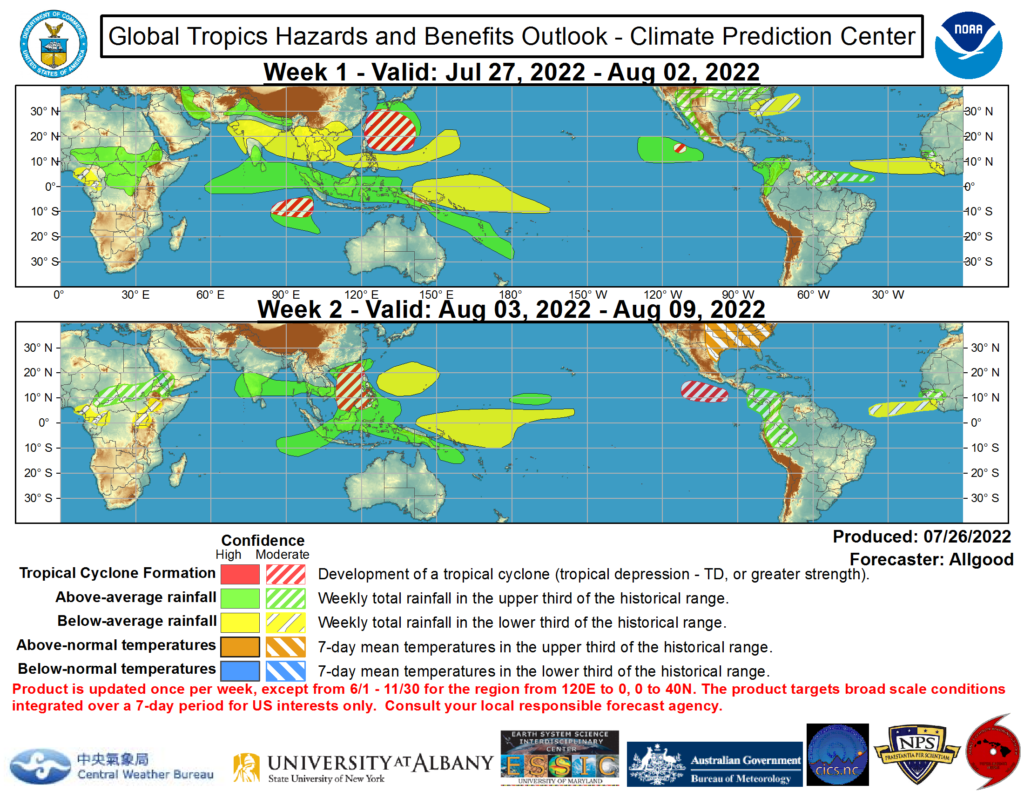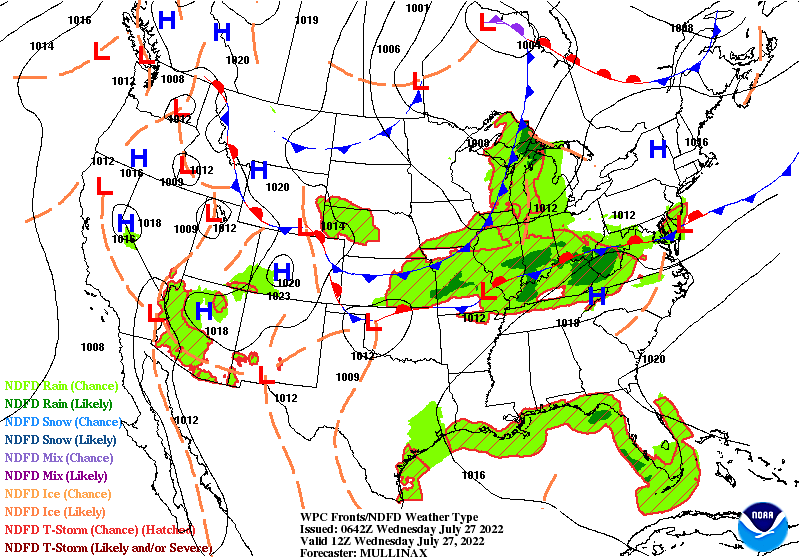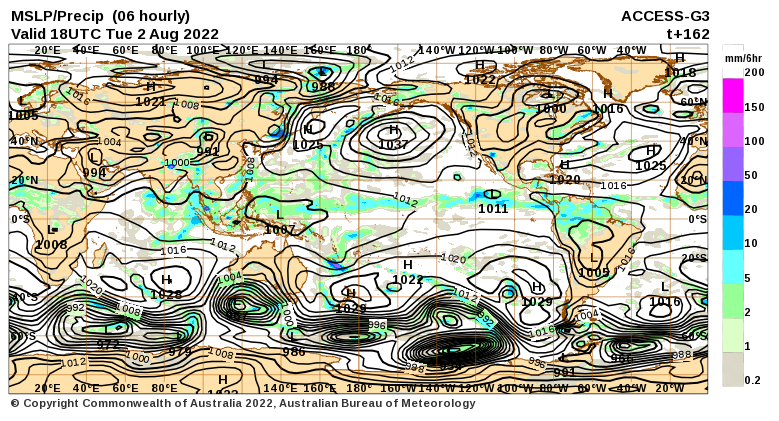Here is what we are paying attention to this evening and the next 48 hours from this evening’s NWS Forecast.
...Moderate Risks of flash flooding are in place with numerous flash floods likely across the Ohio Valley/Central Appalachians over the next few days... ...Monsoonal moisture to cause daily rounds of excessive rainfall and flash flooding across portions of the Southwest and southern/central Rockies and High Plains with Slight to Moderate Risks of excessive rainfall... ...Dangerous heat to bake the Pacific Northwest and portions of the south-central U.S. through midweek...
Continuation of the NWS Short Range Forecast (It is updated twice a day and these updates can be found here.
An upper-level low is forecast to spin across south-central Canada with troughing extending into the north-central and northeastern U.S. over the next few days. This trough/jet stream will be active with shortwave energy, while at the surface a generally west to east oriented quasi-stationary front will extend across central parts of the Plains and Mississippi Valley into the Ohio Valley and Mid-Atlantic, with another couple of cold fronts coming in behind it. Additionally, a Bermuda High and troughing in the Southwest will direct both Gulf of Mexico moisture and ample monsoonal moisture into these regions, providing an environment favorable for multiple rounds of rain and thunderstorms through the end of the workweek. While some strong to severe thunderstorms are possible, the bigger threat will likely be additional flash flooding, given that high rain rates are expected and because rain is likely to fall in the same areas on multiple days on increasingly sensitive/saturated ground conditions in this stagnant pattern with bountiful moisture. A Moderate Risk (level 3/4) of excessive rainfall is in effect through tonight across much of the Lower Ohio Valley and Central Appalachians, meaning numerous flash floods are likely, shown by Flood Watches as well. This risk persists through Wednesday and Thursday over much of West Virginia into eastern Kentucky. Broad Slight Risks extend farther west and south into portions of the Middle/Lower Mississippi Valley and Tennessee Valley as well, where flash flooding is also possible. Additionally, anomalously moist inflow is likely to continue across the Southwest for the next few days, where the monsoon began earlier than usual and has been persistent. This will lead to daily development of heavy showers and thunderstorms throughout the Four Corners states in particular but also into southern Nevada and southeastern California. Areas most vulnerable to flash flooding remain areas near burn scars, in slot canyons, in locations that have overly saturated soils, and in more heavily urbanized areas of the Southwest. For this afternoon/evening into tonight, a Moderate Risk of excessive rainfall is in place across northwestern Arizona where there could be an enhanced chance of flash flooding effects, embedded within a broad Slight Risk that could also see flooding issues. Another sizable Slight Risk persists through Wednesday. The core of the moisture is forecast to move eastward by around Thursday and focus likely heavy rainfall across eastern Colorado, where a Moderate Risk has been added within a Slight over central parts of the Rockies and High Plains. Meanwhile, another threat over the next couple of days will be the heat underneath upper level ridges stretching from the southern tier of the U.S. up into the Northwest. Excessive Heat Warnings and Heat Advisories remain in place today across parts of the Southern Plains and Lower/Middle Mississippi Valley, where oppressively higher dew points lead to sultry heat indices as high as 110 degrees. The Southern Plains and Lower Mississippi Valley are to remain mired in stifling heat until late week when a cold front brings much needed relief in the form of cooler temperatures positioned in the Midwest. The ridging atop the Southeast will keep hot and humid conditions in the forecast with temperatures growing increasingly hotter up and down the East Coast by Thursday. The northwestern U.S. can also expect anomalously hot conditions, with another section of Excessive Heat Warnings and Heat Advisories. Some daily records could be set as highs soar into the triple digits in the Columbia Basin and central Oregon, while the Portland metro area nears 100 degrees with Seattle in the 90s through Friday. The coolest temperatures will be found in the Great Lakes, Midwest, and Southwest.
Maps that relate the forecast to geography can be found by clicking Here for Day 1 and Here for Day 2.
Here is a 60-hour animated forecast map that shows how the short-term forecast is expected to play out.
If it needs to be updated click here.
HAZARDS OUTLOOKS
Click here for the latest complete Day 3 -7 Hazards forecast which updates only on weekdays. Once a week probably Monday or Tuesday I will update the images. I provided the link for reads to get daily updates on weekdays. Use your own judgment to decide if you need to update these images.
Worldwide Tropical Forecast
(This graphic updates on Tuesdays) If it has not been updated, you can get the update by clicking he re
Detailed Maps and Reports for the Western Atlantic and the Pacific Oceans
Below are three maps that summarize the situation for the Atlantic, Eastern and Central Pacific. Additional information can be accessed by clicking HERE
First the Atlantic
Click to view the forecast map and have access to additional information https://www.nhc.noaa.gov/gtwo.php?basin=atlc&fdays=5
Then Eastern Pacific
Click to view the forecast map and have access to additional information https://www.nhc.noaa.gov/gtwo.php?basin=epac&fdays=5
Then Central Pacific
Click to view the forecast map and have access to additional information https://www.nhc.noaa.gov/gtwo.php?basin=cpac&fdays=5
And the Western Pacific
Click to view the forecast map and have access to additional information https://www.metoc.navy.mil/jtwc/jtwc.html
Some Intermediate-Term Outlooks
Links to “Outlook” maps and discussions for three time periods. Days 6 – 10, Days 8 – 14, and Weeks 3 and 4. An outlook differs from a forecast based on how NOAA uses these terms in that an “outlook” presents information from deviation from normal and the likelihood of these deviations.
You have to click on the links because they do not update automatically and I do not want to have stale images in the article. But it is not difficult to click on a link and you get a large image plus a discussion. On Fridays in a separate article, we will show the images and provide a link in this article that article. But remember what you will see is the images as of Friday. But here you can get the current images simply by clicking on them. Then hit the return arrow at the upper left of your screen to return to the article. You will not find this information easily anywhere else.
Right now you can find these maps here (We show them every Friday there but you can click above and find them).
Forecast for Day 6 (Currently Set for Day 6 but the reader can change that)
World Weather Forecast produced by the Australian Bureau of Meteorology. Unfortunately, I do not know how to extract the control panel and embed it into my report so that you could use the tool within my report. But if you visit it Click Here and you will be able to use the tool to view temperature or many other things for THE WORLD. It can forecast out for a week. Pretty cool. Return to this report by using the “Back Arrow” usually found top left corner of your screen to the left of the URL Box. It may require hitting it a few times depending on how deep you are into the BOM tool. Below are the current worldwide precipitation and air pressure forecasts for six days out. They will not auto-update and right now are current for Day 6. If you want the forecast for a different day Click Here I will try to update this map each day but you have the link so you can access the dashboard and get a wide variety of forecasts.
I mostly rely on the reader to interpret world maps. For this map, areas of expected precipitation for the date and time shown are clearly shown.
The number of High-Pressure systems shown is called the Wave Number. Maybe I will discuss WN someday. But it shows how many Rossby Waves there are around the World. Sometimes they are hard to count. Counting Low-Pressure systems should provide the same WN. Rossby Waves are the way the temperature distribution of the Planet remains in balance. It is basically the science of fluid dynamics. It can be very helpful in predicting the movement of weather patterns.
Month to Date Information
(These images do not auto-update – I update them from time to time, but the links are there so just click on them)
Temperature
Precipitation
Month to date Temperature can be found at https://hprcc.unl.edu/products/maps/acis/MonthTDeptUS.png
Month to date Precipitation can be found at https://hprcc.unl.e du/products/maps/acis/MonthPNormUS.png








